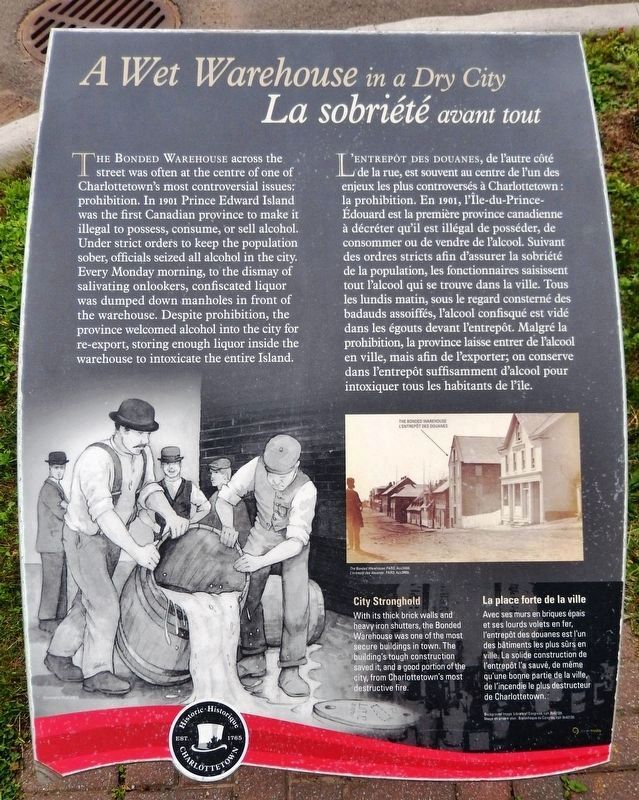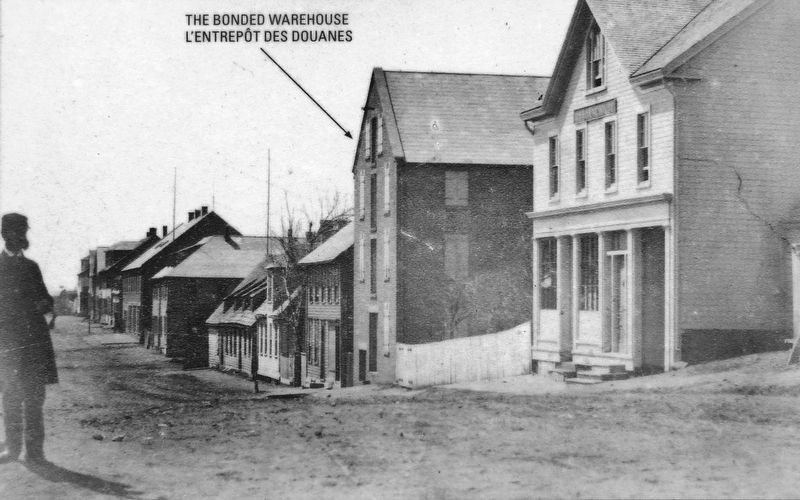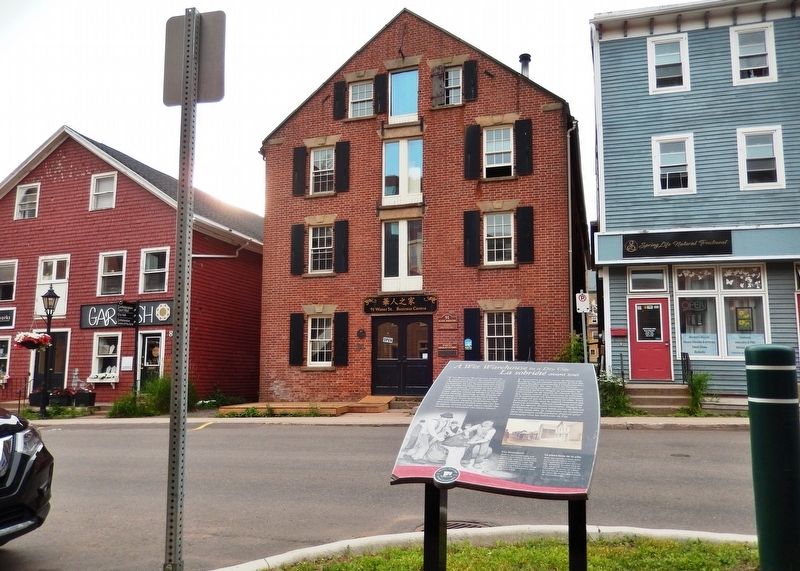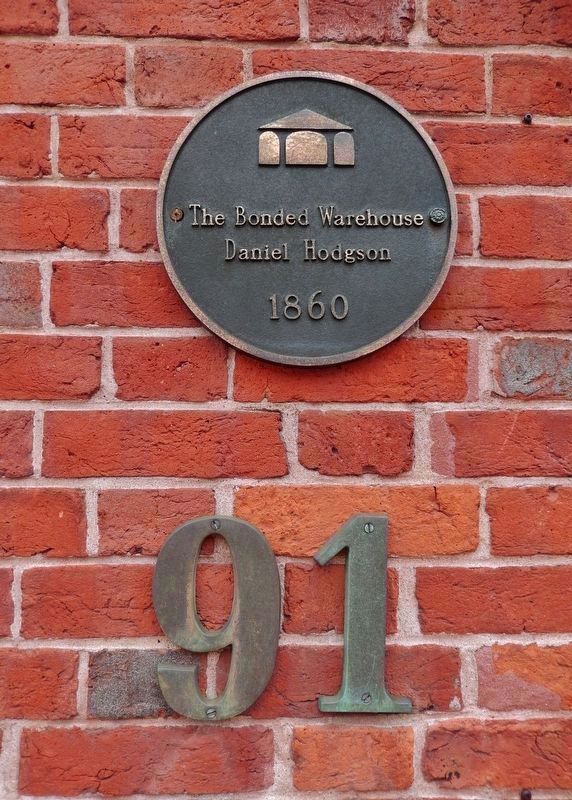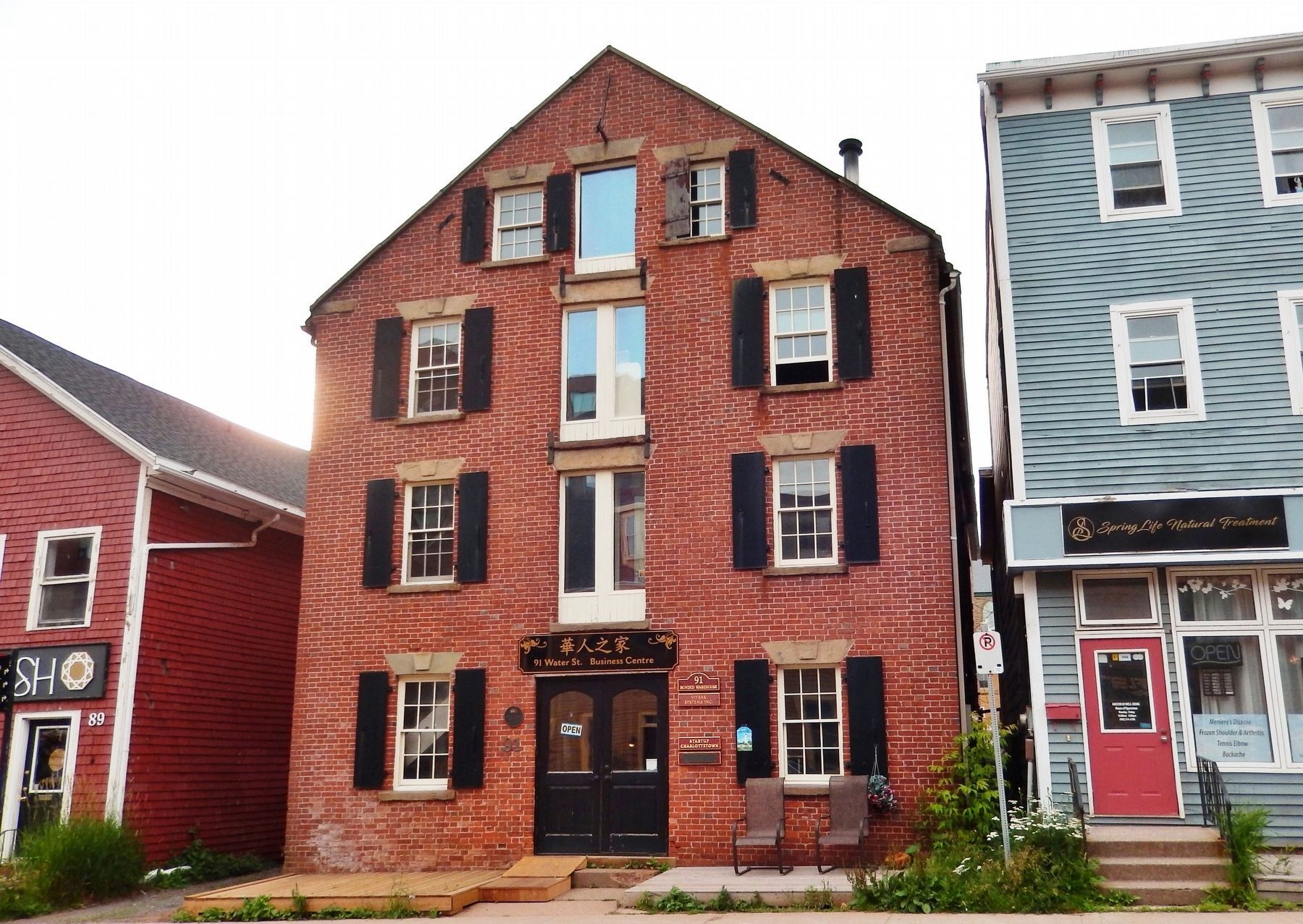Charlottetown in Queens County, Prince Edward Island — The Atlantic Provinces (North America)
A Wet Warehouse in a Dry City / La sobriété avant tout
Inscription.
The Bonded Warehouse across the street was often at the centre of one of Charlottetown's most controversial issues: prohibition. In 1901 Prince Edward Island was the first Canadian province to make it illegal to possess, consume, or sell alcohol. Under strict orders to keep the population sober, officials seized all alcohol in the city. Every Monday morning, to the dismay of salivating onlookers, confiscated liquor was dumped down manholes in front of the warehouse. Despite prohibition, the province welcomed alcohol into the city for re-export, storing enough liquor inside the warehouse to intoxicate the entire Island.
City Stronghold
With its thick brick walls and heavy iron shutters, the Bonded Warehouse was one of the most secure buildings in town. The building's tough construction saved it, and a good portion of the city, from Charlottetown's most destructive fire.
L’entrepôt des douanes, de l'autre côté de la rue, est souvent au centre de l'un des enjeux les plus controversés à Charlottetown : la prohibition. En 1901, l'Île-du-Prince-Édouard est la première province canadienne à décréter qu'il est illégal de posséder, de consommer ou de vendre de l'alcool. Suivant des ordres stricts afin d'assurer la sobriété de la population, les fonctionnaires saisissent tout l'alcool qui se trouve dans la ville. Tous les lundis matin, sous le regard consterné des badauds assoiffés, l'alcool confisqué est vidé dans les égouts devant l'entrepôt. Malgré la prohibition, la province laisse entrer de l'alcool en ville, mais afin de l'exporter; on conserve dans l'entrepôt suffisamment d'alcool pour intoxiquer tous les habitants de l'île.
La place forte de la ville
Avec ses murs en briques épais et ses lourds volets en fer, l'entrepôt des douanes est l'un des bâtiments les plus sûrs en ville. La solide construction de l'entrepôt l'a sauvé, de même qu'une bonne partie de la ville, de l'incendie le plus destructeur de Charlottetown.
Erected by Historic Charlottetown.
Topics. This historical marker is listed in these topic lists: Architecture • Industry & Commerce • Law Enforcement • Waterways & Vessels.
Location. 46° 13.95′ N, 63° 7.441′ W. Marker is in Charlottetown, Prince Edward Island, in Queens County. Marker is on Water Street east of Queen Street, on the right when traveling east. Marker is located beside the sidewalk, overlooking subject building on opposite side of street at 91 Water Street. Touch for map. Marker is at or near this postal address: 94 Water Street, Charlottetown PE C1A 1A6, Canada. Touch for directions.
Other nearby markers. At least 8 other markers are within walking distance of this marker. The Gainsford House (within shouting distance of this marker); Impulsive Ambush / Une attaque impulsive (within shouting distance of this marker); Great George Street Historic District (about 90 meters away, measured in a direct line); Carvell Building (about 90 meters away); William Henry Pope (1825 – 1879) (about 120 meters away); Angus Bernard MacEachern (1759- 1835) (about 120 meters away); Peake House (about 150 meters away); St Dunstan’s Basilica / La basilique St. Dunstan (about 150 meters away). Touch for a list and map of all markers in Charlottetown.
Regarding A Wet Warehouse in a Dry City / La sobriété avant tout. Canadian Register of Historic Places #3166.
Also see . . .
1. Bonded Warehouse. Coroner, Daniel Hodgson had the warehouse built in 1859-1860. It was rented to the Customs Department for use as a bonded warehouse. This is a warehouse where goods are stored without excise or customs duties being charged until after they are removed from the warehouse. The shutters were made of iron and likely deterred theft of the goods inside. Built to last,
it not only survived the Great Fire of 1866, it stopped the fire from moving any further. (Submitted on May 11, 2020, by Cosmos Mariner of Cape Canaveral, Florida.)
2. Fire in Charlottetown, 1866. (from The Herald 18 July, 1866, page 2)
It is our painful duty this week to record one of the most disastrous and destructive fires that has ever visited Charlottetown. Four blocks in the business part of the city, extending in one direction from Dorchester to Water Street, and in the other from Pownal to Great George Street, and comprising upwards of one hundred dwelling houses and places of business, have been destroyed. The fire extended as far east as Water Street, and thence north as far as the Bonded Warehouse, which being a brick building, stopped the fire in this quarter. (Submitted on May 11, 2020, by Cosmos Mariner of Cape Canaveral, Florida.)
3. Nellie J. Banks (Wikipedia). The ship was built by Alfred Banks from Nova Scotia in 1910. She was used for fishing until 1926. In September 1926, Ray Clarke and Captain Edward Dicks bought her for about $2,000. They decided to buy her because they thought she was the perfect vessel for smuggling booze to Prince Edward Island, the province mostly affected by the 1901 prohibition. In 1927, she was seized by the coastguard ship Bayfield.
That was only a small setback for Nellie J. Banks and crew; the boat continued smuggling until she was finally seized in August 1938 by the R.C.M.P cutter Ulna. She was then towed back to Charlottetown, Prince Edward Island. (Submitted on May 11, 2020, by Cosmos Mariner of Cape Canaveral, Florida.)

Photographed By Cosmos Mariner, July 16, 2019
5. Prohibition Marker (just right of warehouse entrance)
In 1927, during Prohibition, there were so many rum-running vessels arrested in the Northumberland Strait that the Pictou Custom-house was full.
This building was rented and made secure by the Federal government on an emergency basis to store the three thousand gallons of rum found abort when the famous schooner Nellie J. Banks was seized.
This building was rented and made secure by the Federal government on an emergency basis to store the three thousand gallons of rum found abort when the famous schooner Nellie J. Banks was seized.
Credits. This page was last revised on May 11, 2020. It was originally submitted on May 9, 2020, by Cosmos Mariner of Cape Canaveral, Florida. This page has been viewed 178 times since then and 16 times this year. Photos: 1, 2, 3, 4, 5, 6. submitted on May 11, 2020, by Cosmos Mariner of Cape Canaveral, Florida.
